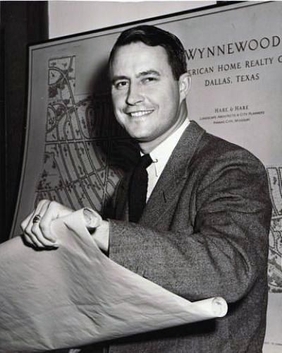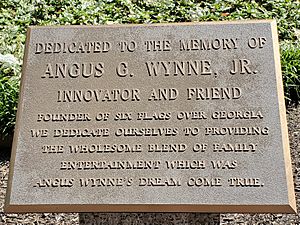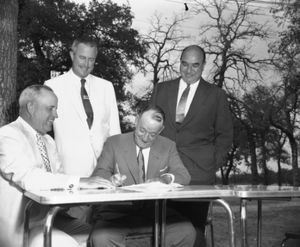Angus G. Wynne facts for kids
Quick facts for kids
Angus G. Wynne
|
|
|---|---|

Wynne in 1947
|
|
| Born |
Angus Gilchrist Wynne Jr.
January 9, 1914 Dallas, Texas, US
|
| Died | March 12, 1979 (aged 65) Dallas, Texas, US
|
| Resting place | Grove Hill Memorial Park, Dallas |
| Occupation |
|
| Spouse(s) |
|
| Children | 4, including Shannon Wynne |
Angus Gilchrist Wynne Jr. (born January 9, 1914 – died March 12, 1979) was an American businessman. He is famous for creating the Six Flags Over Texas theme park. He also started the Wynnewood Shopping Center in Dallas, Texas.
Wynne developed other popular theme parks like Six Flags Over Georgia and Six Flags St. Louis. He was also the CEO of Great Southwest Corp, a company that built a large industrial area in Arlington, Texas. Later in his life, he dreamed of building one of the first water parks in Galveston, Texas, but he passed away before he could finish it.
Contents
Early Life and Education
Angus Wynne Jr. was born on January 9, 1914. His parents were Angus G. Wynne Sr. from Texas and Nemo Shelmire Wynne from Louisiana.
His family moved to Dallas around 1928. His father, Angus G. Wynne Sr., was the first president of the State Bar of Texas. Angus Jr.'s brother, Bedford S. Wynne, helped start the Dallas Cowboys football team.
Angus Wynne Jr. had two sons who also became successful. His son, Angus G. Wynne III, has produced music events since 1968. His other son, Shannon Shelmire Wynne, is a well-known restaurant owner in Dallas. He created popular places like the Flying Saucer Draught Emporium and Flying Fish.
Wynne went to Highland Park High School and graduated in 1931. He was very good at public speaking, which is called Declamation. He continued to compete in Declamation at the University of Texas. He also attended the Lawrenceville School and Washington and Lee University. He earned his Bachelor of Arts degree from the University of Texas in 1938.
While at the University of Texas, Angus and his brother Bedford joined the Phi Kappa Psi fraternity. Their father was one of the founders of this fraternity in 1904. Angus also enjoyed acting and performed in plays at the Austin Little Theatre.
Career Highlights
Starting Out and World War II: 1938-1945
From 1938 to 1940, Angus Wynne Jr. worked in Texas oil fields. Then, he joined the United States Navy Reserve.
He trained to become an officer and served in the Navy during World War II. He was on ships like the USS Nicholson and the USS Grayson. He earned several medals for his service in Europe and Asia. By the end of the war in 1945, he was a Lieutenant Commander.
Building Communities: 1946-1958
After the war, Wynne became involved in real estate. He was the president of American Home Realty. This company bought a large lumber mill in Dallas.
American Home Realty then started a huge housing project called Wynnewood. It included 2,200 houses and 1,000 apartments. This was one of the biggest housing projects of its kind at the time. Wynne became the president of Wynnewood Development Corporation and served on the board of the Wynnewood Bank.
In 1956, Wynne and his uncle, Toddie Lee Wynne, formed a new company called Great Southwest Corporation. They teamed up with other investors to develop a massive industrial park. This park was planned for a ranch located between Dallas and Fort Worth. It was expected to create jobs for 100,000 people. Even famous people like the Rockefeller brothers joined the project.
Wynne also pushed for a private railroad to be built for the industrial park. This railroad would help transport goods for businesses in the area. The Great Southwest Railroad, Inc. was created to build this new rail line.
At first, it was hard to sell space in the industrial park. So, Wynne came up with a new idea to attract people: a sports complex and a theme park called "Southwestland."
Creating Theme Parks: 1958-1970
The mayor of Arlington suggested that Wynne and his family visit Disneyland in California. This trip gave Wynne a new idea. He decided to build a theme park that celebrated the history of Texas.
Wynne's company, Great Southwest Corporation, hired experts to help design the park. In January 1960, they announced plans to raise money for the construction.
Construction on the park began in August 1960. Wynne originally wanted to call it "Texas Under Six Flags," but his wife said, "Texas ain't under nothing!" So, he changed the name to Six Flags Over Texas. The "six flags" represent the six different countries that have ruled over Texas throughout history: France, Spain, Mexico, the Republic of Texas, the Confederate States of America, and the United States of America.
Wynne hired talented people, including designers who had worked at Metro-Goldwyn-Mayer and Disneyland. They helped make sure the park was amazing.
When Six Flags Over Texas opened on August 5, 1961, it was a huge success! Over 8,000 people visited on the first day.
The park's success helped Great Southwest Corporation make a profit for the first time in 1962. Because of this success, Wynne was asked to help with the 1964 New York World's Fair. He proposed building a large theater called the Music Hall.
Wynne invested a lot of money into the Music Hall and a Texas pavilion for the fair. He wanted to bring the same fun atmosphere from Six Flags Over Texas to New York. He even brought 300 employees from the park to work as "hosts and hostesses" at the fair. The Music Hall featured a musical show called To Broadway With Love, which critics loved. However, the Texas Pavilion did not make enough money, and the company involved filed for bankruptcy.
In 1965, Wynne's company bought land in Atlanta, Georgia, to build another theme park. This park became Six Flags Over Georgia. Later, in 1971, he opened Six Flags St. Louis in Missouri.
Developing new parks from scratch was very expensive. So, Six Flags started buying existing parks that had potential. In 1975, they bought AstroWorld in Houston, Texas. Two years later, they bought Great Adventure in New Jersey. The last park acquired during Wynne's lifetime was Magic Mountain in California in 1979.
Although Angus Wynne Jr. was no longer directly involved with the company when he passed away, Six Flags continued to grow. It became one of the largest regional theme park chains in the world.
Leaving Great Southwest
In July 1970, Angus G. Wynne, Jr. became the president and CEO of Great Southwest Corp. However, the parent company of Great Southwest faced financial problems. This caused difficulties for Great Southwest, and some of its credit was stopped.
In October 1970, a new president was chosen for Great Southwest. Angus Wynne Jr. and several other leaders left their positions. There were some disagreements about money and how the company was managed, but these issues were settled in 1972.
Personal Life
Angus Wynne married Joanne Estelle Wynne on February 26, 1941. They had four children: Angus III, David, Mary, and Shannon. They divorced in 1978. Later that year, Wynne married his second wife, Margaret, and gained two step-daughters.
Wynne was also very involved in his community. In 1954, he joined a group to help migrant workers. In 1955, he helped raise money for the Texas Boy Scouts of America. He also spoke at conferences about city development and zoning. He supported the University of Texas, Baylor University Medical Center, and Children's Medical Center of Dallas. He also worked with the Cotton Bowl Council, the State Fair of Texas, and the National Conference of Christians and Jews.
Later Life and Legacy

In 1973, when he was 59, Wynne had a major stroke. He never fully recovered from it.
Angus Wynne Jr. passed away on March 12, 1979, from a heart attack. He was buried in Grove Hill Memorial Park in Dallas, Texas.
His contributions to real estate and theme parks left a lasting impact. In 2001, State Highway 360 through Arlington was named the Angus G. Wynne Jr. Freeway in his honor. In 2013, there was a proposal to name the section of State Highway 360 through Fort Worth after him as well.
See Also
- Great_Southwest_Industrial_District
Images for kids





